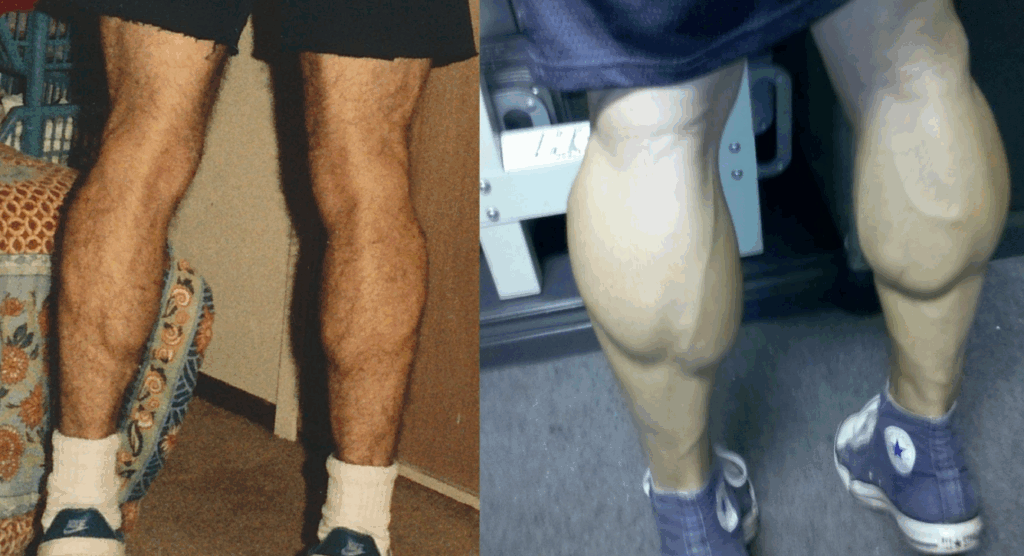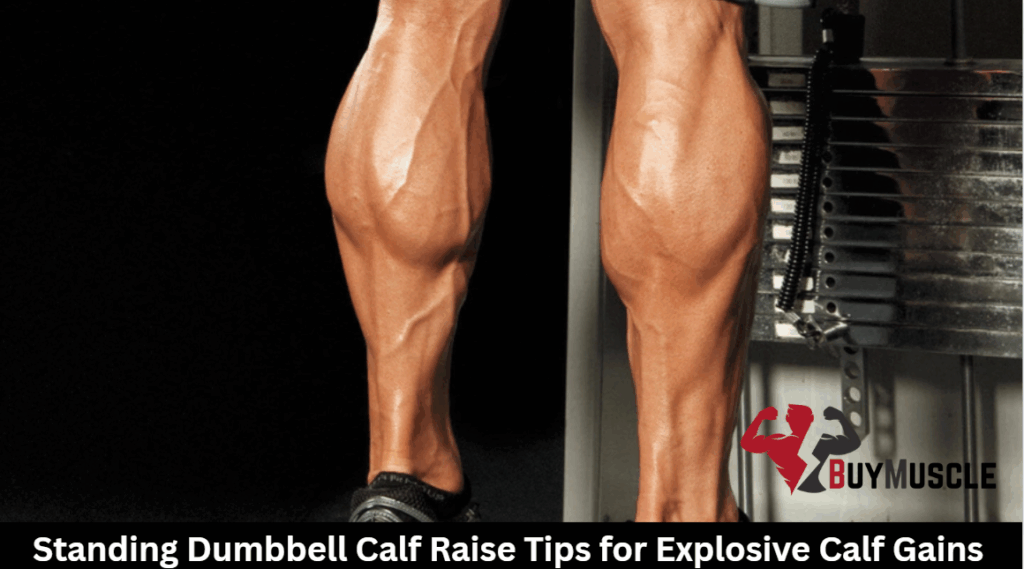For explosive calf gains with standing dumbbell raises, maintain perfect form with feet hip-width apart and rise fully onto your toes, squeezing for 1-2 seconds at the top. Control the descent, allowing heels to drop below the platform level. Implement progressive overload by increasing weight 5-10% every 2-3 weeks and vary your tempo (try a 1-3-1 count). Train calves 2-3 times weekly with 48 hours between sessions. The advanced variations below will help shatter your plateaus.
The Foundation of Calf Development
Precision matters when performing standing dumbbell calf raises. Your technique directly determines the level of muscle activation you’ll achieve in both the gastrocnemius and soleus muscles. Start with feet hip-width apart, dumbbells at your sides, and shoulders relaxed. Rise onto your toes completely, squeezing your calves at the top for 1-2 seconds before lowering with control.
The full range of motion is vital. Allow your heels to drop below platform level to maximize the stretch before rising again. During the movement, keep your knees slightly bent but steady.
Keep a steady pace of 2 seconds up, hold, and 3 seconds down. This planned execution helps you recover better between workouts and stops cheating that happens when you try to keep up with the pace.

Progressive Overload Strategies for Stubborn Calves
Calves often remain stubborn despite consistent training, requiring strategic progressive overload to stimulate new growth. When performing the standing dumbbell calf raise, gradually increase weight by 5-10% every 2-3 weeks while maintaining proper form to trigger muscle hypertrophy.
Don’t just focus on weight. Manipulate other variables too. Increase your rep range from 12-15 to 15-20, or slow down your tempo to create more time under tension. Another effective strategy is adding an extra set to your calf training routine while keeping intensity high.
For truly resistant calves, try performing your standing dumbbell calf raises on an elevated platform to increase range of motion, creating a deeper stretch that forces adaptation and new growth.

Optimizing Tempo and Range of Motion
To maximize muscle development in your standing dumbbell calf raises, you’ll need to master both tempo and range of motion. Start by slowing down your eccentric phase to 3-4 seconds, creating more time under tension for your calf muscles. This controlled lowering intensifies the stretch and stimulates greater muscle fiber recruitment.
Don’t cheat yourself on range of motion. Descend until you feel a complete stretch in your calves, then drive upward explosively through your toes. This full extension-to-contraction cycle activates more muscle fibers than partial reps. For explosive gains, try a 1-3-1 tempo (one second up, three seconds down, one-second pause at the bottom) to optimize both the strength and hypertrophy components of your training.
Varying your tempo between workouts prevents adaptation and continues to challenge your muscles.

Frequency, Volume, and Intensity
While many lifters focus solely on form, the strategic manipulation of training variables ultimately determines your calf development. For ideal growth, train calves 2-3 times weekly with at least 48 hours between sessions.
Volume should range from 8-12 sets weekly, with intensity structured as 3-4 sets of 12-15 reps for hypertrophy or 4-5 sets of 6-8 reps for strength training. Higher intensity sessions (heavier weights) require more recovery than higher volume workouts.
Don’t fall into the trap of treating calves as an afterthought. Progressive overload remains essential. Aim to increase weight by 5% every 2-3 weeks while maintaining proper form. Remember that calves respond best to varied stimuli, so alternate between high and moderate volume approaches.
Advanced Variations to Break Through Plateaus
When standard calf raise protocols no longer produce results, it’s time to implement advanced variations that challenge your lower legs in new ways. Try single-leg raises with heavier dumbbells to intensify the work on each gastrocnemius muscle while improving balance. Alternating between fast and slow tempos during ankle plantar flexion creates metabolic stress that stimulates growth.
For targeting the deeper soleus muscle, perform partial-range pulses at the top of each rep while maintaining tension. Another effective variation is the drop-set method. Start with heavy dumbbells for eight reps, then immediately switch to lighter weights for 12-15 more. You can also elevate your toes on a platform to increase the stretch at the bottom position, creating more mechanical tension throughout both calf muscles.
Frequently Asked Questions
Are Genetics Truly Limiting for Calf Development?
Genetics influence your calf development, but they’re not destiny. You can overcome genetic limitations through targeted training, a full range of motion, progressive overload, and consistency. Don’t let genetics become your excuse.
Can Standing Dumbbell Calf Raises Help With Ankle Stability?
Yes, they’ll strengthen the muscles supporting your ankles. As you balance while lifting, your stabilizer muscles engage, improving ankle joint control and reducing injury risk during athletic movements and daily activities.
How Do Nutrition and Hydration Specifically Impact Calf Recovery?
Protein helps repair your torn calf muscle fibers, while proper hydration prevents cramping and improves nutrient delivery. You’ll need both to reduce soreness and guarantee your calves recover fully between workouts.
Should I Train Calves Before or After Main Leg Exercises?
Train calves after your main leg exercises. You’ll have more energy for compound movements first, while your calves will still respond well even when pre-fatigued. This approach maximizes your overall leg development.
Will Calf Training Improve Vertical Jump Performance?
Yes, calf training will improve your vertical jump performance. Strong calves generate more power during the push-off phase, enhancing explosive force production when you jump. Add plyometric calf exercises for best results.








